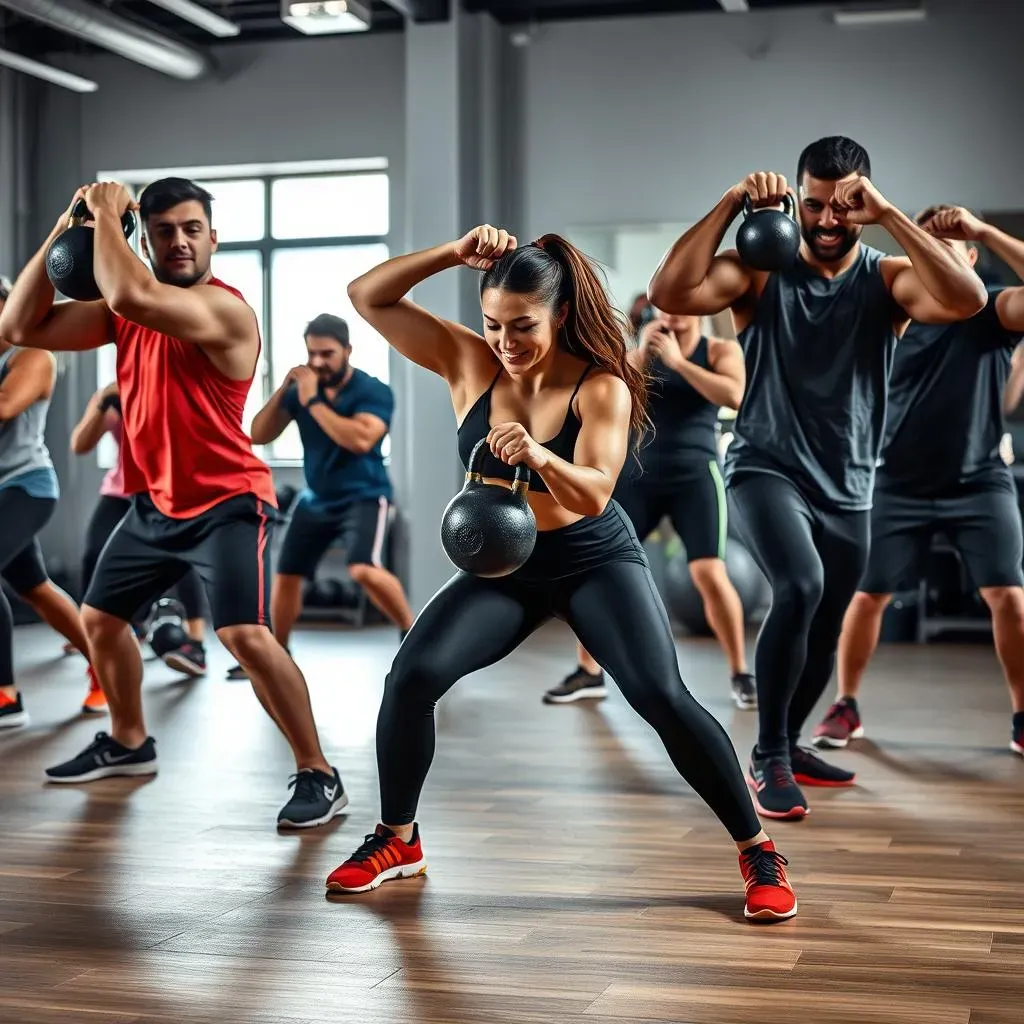Table of Contents
Are you a man looking to build serious strength, torch fat, and unlock explosive power? Then it's time to ditch the crowded gym and discover the transformative potential of the kettlebell. Akettlebell full body workout for menisn't just another fitness fad; it's a time-tested method for forging a resilient, athletic physique. Forget endless hours on the treadmill or isolating muscles with machines. Kettlebells engage your entire body with every swing, clean, and press, delivering unparalleled results in less time.
Why Kettlebell Full Body Workouts Are a Game Changer for Men

Why Kettlebell Full Body Workouts Are a Game Changer for Men
Efficiency: Time is Money, and Kettlebells Save You Both
Let's face it, fellas, we're busy. Between work, family, and trying to maintain some semblance of a social life, who has hours to spend in the gym? That's where kettlebells come in. Unlike traditional weightlifting, which often isolates specific muscle groups, kettlebell exercises are inherently full-body movements. Think swings, cleans, snatches – these aren't just bicep curls; they're dynamic exercises that engage your core, legs, back, and shoulders all at once. You're essentially getting a complete workout in half the time. Plus, the cardio element is built right in, so you're burning fat and building muscle simultaneously.
I remember when I first started using kettlebells, I was amazed at how much I could accomplish in just 30 minutes. I used to spend an hour or more doing separate cardio and strength training sessions. With kettlebells, I could get a better workout in less time, leaving me more time for, well, everything else!
Functional Strength: Building a Body That Performs
Forget about building purely aesthetic muscle that looks good but doesn't translate to real-world strength. Kettlebell training focuses on functional strength, which means building a body that can perform real-life tasks with ease and power. Kettlebell exercises mimic natural movement patterns, improving your balance, coordination, and overall athleticism. Whether you're hauling groceries, playing sports, or just navigating daily life, the strength you build with kettlebells will make you more capable and resilient.
Think about the kettlebell swing. It's not just about lifting a weight; it's about generating power from your hips and core, just like you would when swinging an axe or throwing a ball. This kind of functional strength is invaluable in everyday life and can significantly improve your performance in other physical activities.
Versatility: From Beginner to Beast, Kettlebells Adapt to You
One of the best things about kettlebells is their versatility. Whether you're a complete beginner or a seasoned athlete, you can tailor your kettlebell workouts to match your fitness level and goals. There's a huge range of exercises to choose from, and you can easily adjust the weight, reps, and sets to create a workout that's challenging but achievable. As you get stronger, you can progress to more advanced exercises and heavier weights, ensuring that you're always pushing yourself to improve. Plus, you don't need a ton of equipment or space to get a great kettlebell workout. A few kettlebells and a small area are all you need to transform your body.
I've seen guys who were initially intimidated by kettlebells completely transform their bodies and their fitness levels. It's all about starting slow, mastering the fundamentals, and gradually progressing as you get stronger. Kettlebells are a tool that can grow with you, providing a lifetime of challenging and rewarding workouts.
Benefit | Description |
|---|---|
Time Efficiency | Full-body workouts in less time. |
Functional Strength | Builds strength for real-life activities. |
Versatility | Adaptable for all fitness levels. |
Essential Kettlebell Exercises for a Full Body Transformation

Essential Kettlebell Exercises for a Full Body Transformation
The Kettlebell Swing: King of the Hill
If there's one exercise that defines kettlebell training, it's the swing. This dynamic movement works your posterior chain – glutes, hamstrings, and back – like nothing else. It's also a fantastic cardio exercise, elevating your heart rate and burning a ton of calories. The swing teaches you to generate power from your hips, not your arms, which is a crucial skill for many other kettlebell exercises. Mastering the swing is the foundation for building a strong, athletic body with kettlebells.
I remember when I first started doing swings, I was using my arms way too much. My lower back was sore, and I wasn't getting the results I wanted. Once I learned to hinge properly at the hips and engage my glutes, everything changed. The swing became a powerful, fluid movement that transformed my physique and my performance in other activities.
The Goblet Squat: Your New Best Friend for Leg Day
The goblet squat is a fantastic exercise for building lower body strength and improving your squatting mechanics. Holding the kettlebell close to your chest forces you to maintain an upright posture, which helps to improve your form and prevent injuries. It's also a great way to learn how to squat deeper and more comfortably. The goblet squat is an excellent exercise for beginners and advanced lifters alike.
I often recommend the goblet squat to people who struggle with traditional barbell squats. The kettlebell helps to counterbalance your weight and makes it easier to maintain proper form. It's a great way to build the strength and confidence you need to progress to more advanced squat variations.
The Turkish Get-Up: The Ultimate Test of Strength and Coordination
The Turkish get-up (TGU) is a complex, full-body exercise that challenges your strength, stability, and coordination. It involves transitioning from lying on the ground to standing upright, all while holding a kettlebell overhead. The TGU works every muscle in your body and improves your mobility, balance, and core strength. It's a challenging exercise, but the rewards are well worth the effort.
The first time I tried a TGU, I felt like a newborn giraffe trying to stand up. It was awkward and unstable, but I kept practicing, and eventually, I was able to perform the movement smoothly and confidently. The TGU not only built my strength and coordination but also improved my mental toughness. It taught me to break down complex movements into smaller, manageable steps, which is a valuable skill in all areas of life.
Exercise | Benefits |
|---|---|
Kettlebell Swing | Works posterior chain, cardio, power development. |
Goblet Squat | Builds lower body strength, improves squat mechanics. |
Turkish Get-Up | Full-body strength, stability, coordination. |
The Ultimate 6Week Kettlebell Full Body Workout Plan for Men

The Ultimate 6Week Kettlebell Full Body Workout Plan for Men
Phase 1: Building a Solid Foundation (Weeks 1-2)
Alright, listen up, this is where we lay the groundwork. The first two weeks are all about mastering the fundamental movements and building a solid base of strength and endurance. We're not going heavy here; focus on perfect form and controlled movements. Think of it like building a house – you need a strong foundation before you can start adding the fancy stuff.
This phase focuses on higher reps with moderate weight to improve your muscular endurance and nail down proper technique. We're talking kettlebell swings, goblet squats, push-ups, and rows. Don't underestimate the importance of these basics. They're the key to unlocking your full potential later on.
Phase 2: Increasing Strength and Power (Weeks 3-4)
Now that you've got the basics down, it's time to ramp things up. In weeks 3 and 4, we'll be increasing the weight and decreasing the reps to focus on building strength and power. We'll also be introducing some more challenging exercises like cleans and snatches.
Remember to listen to your body and don't push yourself too hard, too soon. It's better to progress gradually than to risk injury. Focus on maintaining good form, even as the weight increases. This is where you'll start to see some serious gains in strength and muscle mass.
Week | Focus | Reps | Sets |
|---|---|---|---|
1-2 | Foundation | 12-15 | 3 |
3-4 | Strength & Power | 6-8 | 4 |
Phase 3: Maximizing Muscle Growth and Conditioning (Weeks 5-6)
The final two weeks are all about maximizing muscle growth and conditioning. We'll be using a combination of heavy lifting and high-intensity interval training (HIIT) to push your body to its limits. This is where you'll really start to see the results of your hard work.
Expect to incorporate exercises like Turkish Get-Ups, Windmills, and Renegade Rows. These movements demand full-body coordination and stability, pushing your strength and endurance to new heights. Don't be afraid to challenge yourself, but always prioritize proper form and listen to your body. By the end of this phase, you'll not only look stronger but feel incredibly powerful and conditioned.
Kettlebell Workout: Mastering Form and Preventing Injuries

Kettlebell Workout: Mastering Form and Preventing Injuries
Prioritize Proper Form Over Heavier Weight
Listen, I get it. You want to lift heavy, feel strong, and see results fast. But trust me on this one: with kettlebells, form is everything. Sacrificing technique for the sake of adding weight is a recipe for disaster. You'll not only increase your risk of injury but also limit your gains in the long run. Start with a weight that allows you to perform each exercise with perfect form, and gradually increase the load as you get stronger. It's a marathon, not a sprint.
I've seen so many guys try to muscle through kettlebell exercises with sloppy form, and it always ends the same way: with a tweaked back, a strained shoulder, or some other nagging injury. It's just not worth it. Take the time to learn the proper technique, and your body will thank you for it.
Common Mistakes and How to Avoid Them
Kettlebell training is incredibly effective, but it's also technically demanding. There are a few common mistakes that I see people make all the time, and I want to help you avoid them. One of the biggest is using your arms too much during exercises like the swing and the clean. Remember, these are hip-hinge movements, not arm exercises. Focus on generating power from your glutes and hamstrings, and let your arms act as guides.
Another common mistake is rounding your back during squats and deadlifts. This puts unnecessary stress on your spine and can lead to serious injuries. Keep your back straight, your core engaged, and your chest up. Finally, don't forget to breathe! Proper breathing is essential for maintaining stability and generating power.
Mistake | Solution |
|---|---|
Using arms too much in swings | Focus on hip hinge, engage glutes. |
Rounding back during squats | Keep back straight, engage core. |
Holding breath | Breathe deeply and consistently. |
Warm-Up and Cool-Down: Essential for Injury Prevention
Don't ever skip your warm-up and cool-down. These are crucial for preparing your body for exercise and helping it recover afterward. A good warm-up should include dynamic stretches like arm circles, leg swings, and torso twists. This will increase blood flow to your muscles and improve your range of motion.
A proper cool-down should include static stretches, holding each stretch for 30 seconds. Focus on stretching the muscles you worked during your workout, such as your hamstrings, glutes, and back. A good warm-up and cool-down will significantly reduce your risk of injury and improve your overall performance.
Beyond the Basics: Advanced Kettlebell Training for Men

Beyond the Basics: Advanced Kettlebell Training for Men
Unlocking Explosive Power with Kettlebell Ballistic Exercises
So, you've mastered the basics – swings, goblet squats, get-ups – and you're feeling pretty good about yourself. That's awesome! But if you really want to take your kettlebell training to the next level, it's time to explore the world of ballistic exercises. These are dynamic, explosive movements that build serious power, improve your athleticism, and challenge your coordination in new ways. Think about movements like the kettlebell snatch, clean and jerk, and the double kettlebell variations of these lifts. These aren't just about lifting weight; they're about moving weight with speed and precision.
I remember the first time I tried a kettlebell snatch. It felt awkward and unstable, and I kept banging the kettlebell against my forearm. But I stuck with it, focusing on proper technique and gradually increasing the weight. Eventually, I was able to perform the snatch smoothly and powerfully, and I noticed a huge improvement in my overall strength and athleticism. Ballistic exercises are challenging, but they're also incredibly rewarding.
Maximizing Muscle Growth with Advanced Kettlebell Techniques
While kettlebells are often associated with functional fitness and conditioning, they can also be a powerful tool for building muscle. To maximize muscle growth with kettlebells, you need to go beyond the basic exercises and explore some more advanced techniques. One of my favorites is using kettlebells for loaded carries. Exercises like the farmer's walk, the overhead carry, and the suitcase carry challenge your core stability, grip strength, and overall endurance, while also stimulating muscle growth throughout your body.
Another great technique is to use kettlebells for unilateral exercises, which means working one side of your body at a time. Exercises like the single-leg deadlift, the single-arm press, and the single-arm row force your core to work harder to stabilize your body, which can lead to increased muscle growth and improved balance and coordination. Don't be afraid to experiment with different rep ranges, tempos, and rest periods to find what works best for you. Remember, building muscle with kettlebells is all about challenging your body in new and different ways.
Technique | Description | Benefits |
|---|---|---|
Ballistic Exercises | Explosive movements like snatches and cleans. | Build power, improve athleticism. |
Loaded Carries | Farmer's walks, overhead carries. | Increase core stability, grip strength. |
Unilateral Exercises | Single-leg deadlifts, single-arm presses. | Improve balance, core strength, muscle growth. |
Integrating Kettlebells into a Comprehensive Training Program
Kettlebells are a fantastic tool, but they shouldn't be the only tool in your toolbox. To achieve optimal results, it's important to integrate kettlebells into a comprehensive training program that includes other forms of exercise, such as traditional weightlifting, bodyweight training, and cardiovascular exercise. This will help you build a well-rounded physique, improve your overall fitness, and prevent plateaus.
For example, you might start your workout with some heavy barbell squats and deadlifts to build strength, then move on to kettlebell swings and snatches for power and conditioning, and finish with some bodyweight exercises like pull-ups and push-ups for muscle growth. The key is to find a balance that works for you and allows you to continually challenge your body in new and different ways. Remember, variety is the spice of life, and it's also the key to long-term fitness success.
Conclusion: Forge Your Strongest Self with Kettlebell Training
The journey to a stronger, leaner, and more powerful you doesn't require endless hours in a gym or a cabinet full of supplements. With akettlebell full body workout mencan unlock their athletic potential, build functional strength, and achieve a level of fitness they never thought possible. By mastering the fundamental exercises, following a structured program, and prioritizing proper form, you can transform your body and your life. So, pick up that kettlebell, embrace the challenge, and get ready to forge your strongest self.